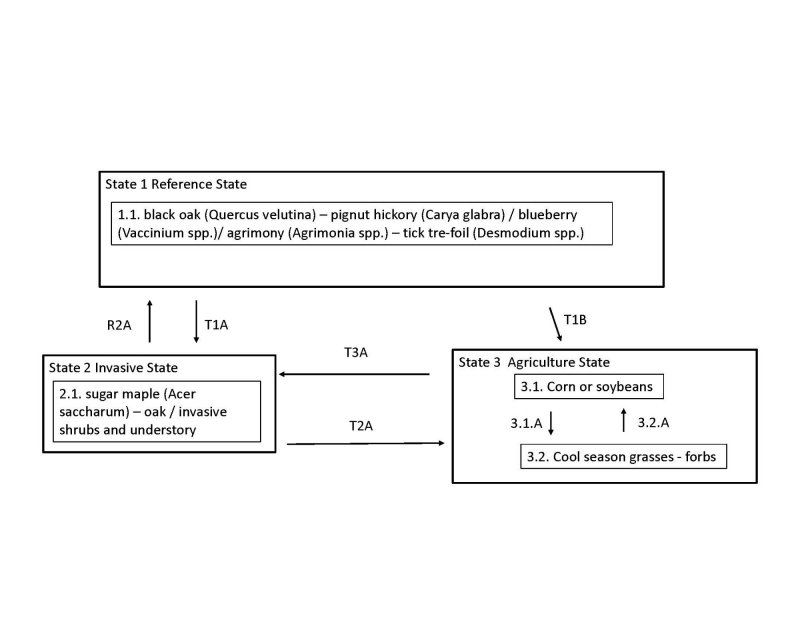
Natural Resources
Conservation Service
Ecological site F114XA302IN
Acidic Upland Forest
Last updated: 9/26/2024
Accessed: 12/21/2025
General information
Provisional. A provisional ecological site description has undergone quality control and quality assurance review. It contains a working state and transition model and enough information to identify the ecological site.
MLRA notes
Major Land Resource Area (MLRA): 114X–Southern Illinois and Indiana Thin Loess and Till Plain
MLRA 114A makes up about 4,550 square miles (11,795 square kilometers). The three parts of this MRLA are mostly in the Till Plains Section of the Central Lowland Province of the Interior Plains. The western third of the western part is in the Highland Rim Section of the Interior Low Plateaus Province of the Interior Plains. The eastern half of the eastern part is in the Kanawha Section of the Appalachian Plateaus Province of the Appalachian Highlands. Both large and small tributaries of the Ohio River dissect the nearly level to very steep glaciated uplands in this area. The major streams and rivers have well defined valleys with broad flood plains and numerous stream terraces. The flood plains along the smaller streams are narrow. Broad summits are nearly level to gently sloping. Elevation ranges from 320 feet (100 meters) on the southernmost flood plain along the Ohio River to 1,250 feet (380 meters) on the highest ridges. Local relief is mainly 10 to 50 feet (3 to 15 meters), but it can be 50 to 100 feet (15 to 30 meters) along drainageways and streams. Also, the Ohio River bluffs are as much as 300 feet (90 meters) above the river valley floor.
Classification relationships
USFS: 222 Eastern Broadleaf Forest (Continental) Province.
Homoya's Natural Regions of Indiana: Bluegrass Region
The following NatureServe Explorer Ecological System has a high level of probability to match the ecological site found on these soils. Southern Interior Low Plateau Dry-Mesic Oak Forest-Unique Identifier: CES202.898
Ecological site concept
Acidic Upland Forest sites were historically a mature hardwood forest community with oaks and hickories being the dominant canopy species. These upland sites are found on acidic soils. Decades of disturbance (logging, grazing, invasive vegetation, fire suppression, etc.) have impacted most sites that are still wooded. These disturbances have transitioned most sites to a mixed hardwood forest with less of an oak component that was historically present and an increase in maple, ash and tulip poplar. The majority of areas have now been converted for agricultural use.
Associated sites
| F114XA502IN |
Till Uplands Till Upland Forest. These sites are on upland till plains. |
|---|
Similar sites
| F114XA305IN |
Non-Acidic Upland Forest The non-acidic upland forest sites also are dominated by a oak-hickory forest; however the species on these sites are those adapted to calcareous soils. |
|---|
Table 1. Dominant plant species
| Tree |
(1) Quercus velutina |
|---|---|
| Shrub |
(1) Vaccinium |
| Herbaceous |
(1) Agrimonia |
Click on box and path labels to scroll to the respective text.
Ecosystem states
| T1A | - | Disturbance; introduction of non-native plants |
|---|---|---|
| T1B | - | Clearing; site preparation; seeding; agricultural management |
| R2A | - | Brush control; weed control; timber stand improvement inputs |
| T2A | - | Clearing; site preparation; tillage; seeding; weed control; agricultural management. |
| T3A | - | Abandonment |
State 1 submodel, plant communities
State 2 submodel, plant communities
State 3 submodel, plant communities
| 3.1.A. | - | Planting; weed control; grassland management |
|---|---|---|
| 3.2.A. | - | Site preparation; tillage; seeding; weed control; row crop management |
